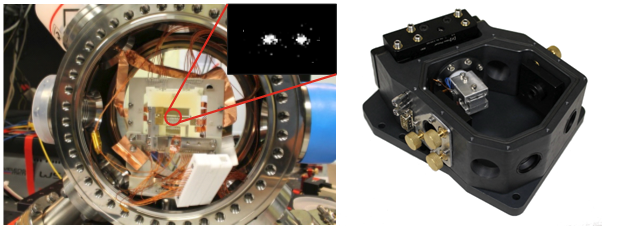Einstein’s general theory of relativity predicts that clocks in a gravitational potential tick slower than clocks outside of it. On Earth, this translates to a relative frequency change of 10−16 per meter of height difference. Comparing the frequency of a “probe” clock with a “reference” clock (both at rest) provides a direct measure of the difference in gravity potential between the two clocks. This novel technique has been dubbed “chronometric leveling” and is a central application of relativistic geodesy. Optical frequency standards have recently demonstrated a fractional frequency uncertainty of 10−17 which enables their use for relativistic geodesy at an absolute level of ten centimeters. The vision of this project is to demonstrate chronometric leveling with transportable clocks and to establish a measurement technique that is directly sensitive to the geopotential.
We have compared two optical clocks located in Braunschweig and Paris via an optical fiber link (Lisdat et al.). The achieved uncertainty of 5×10−17 is equivalent to a height resolution of 0.5 m. With data from colleagues in project C04, we have been able to validate geodetic methods and reference systems with our clocks. This approach provides a new capability to connect classical geodetic measurements and to establish anchor measurements for widely spread height grids. The lattice clock at Braunschweig is also capable to sense frequency modulations at the level of 1×10−17 caused e.g. by tidal influences on averaging times as short as few 100 s (Al-Masoudi et al.). Furthermore, the acquired data are analyzed in a physical context to test cornerstones as the Einstein equivalence principle (Delva et al.).
To gain further flexibility in the choices of measurement sites, we have built and evaluated a transportable optical lattice clock (Vogt et al., Koller et al.). Currently, the clock is evaluated to an uncertainty level of 7×10−17, which corresponds to less than 1 m height resolution. We are confident that we can achieve 10 cm accuracy with further evaluation of the clock.
This clock was successfully used in a measurement campaign in collaboration with the European project International Timescales with Optical Clocks, in which it was operated in the underground laboratory Laboratoire Souterrain de Modane in the French Alps. Its frequency was measured by clocks in the Italian metrology institute INRIM, which is located 90 km away in Torino. We were able to resolve the relativistic red shift due to the 1000 m height difference between both locations and validated the transportable clock by local comparisons at Torino.
In a parallel activity, a transportable clock based on a single aluminium ion (Al+) is set up. Al+ promises very high accuracy, potentially even below 10-18 relative frequency uncertainty, since it’s clock transition is very insensitive to external perturbing fields (Ludlow et al.). Since Al+ has no accessible cooling transition, we employ quantum logic spectroscopy using a co-trapped Ca+ ion to provide sympathetic cooling and quantum state readout. We are evaluating the dominant shifts of the clock, in particular the black-body radiation shift (Doležal M. et al.) and shifts caused by the relativistic Doppler effect (also called time dilation shift). A novel cooling scheme based on a double electromagnetically-induced transparency (EIT) resonance has been realized by applying three phase coherent laser fields (Scharnhorst et al.) and is currently being investigated. The light fields enable fast (sub-ms) cooling of all six motional modes of the two-ion crystal to near the motional ground state, thus suppressing motion-induced shifts. Transportability of the ion clock system will be achieved by employing fiber-based components where available and through miniaturization and ruggedization of critical components, such as frequency doubling cavities and lasers.
The high accuracy of a single ion clock comes at the expense of increased averaging time to achieve a certain resolution when compared to a many-atom lattice clock. It is therefore crucial for geodetic applications to optimize the interrogation protocol (Leroux et al.) and to reduce the phase noise of the clock laser. Towards this goal, we develop highly-stable transportable clock lasers and new concepts, such as laser pre-stabilization using a highly stable lattice clock in a hybrid clock approach.
Having demonstrated the potential of optical clocks for geodetic applications, we will perform similar measurements at selected locations of geodetic interest. The availability of two transportable systems will allow us to perform measurements between sites that are not connected by a phase-stabilized fiber link to PTB or another metrology institute. We expect that we can improve the reliability and performance considerably such that chronometric levelling on the centimeter-level will become feasible and advance to a standard technique in geodesy.
Principal Investigators
Physikalisch-Technische Bundesanstalt
Bundesallee 100
38116 Braunschweig
Physikalisch-Technische Bundesanstalt
Bundesallee 100
38116 Braunschweig
Institute for Experimental Quantum Metrology
Institute for Experimental Quantum Metrology







